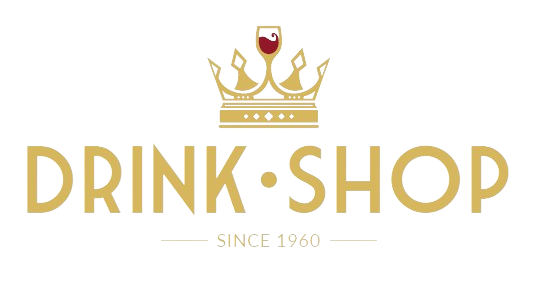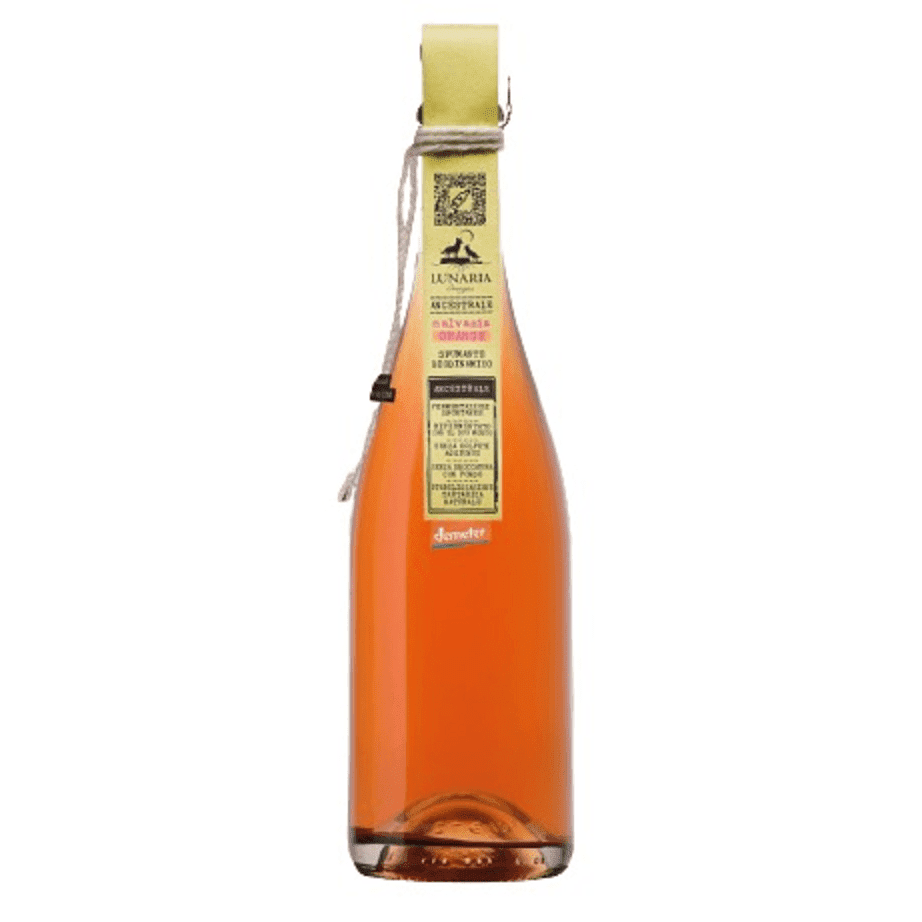CANTINA ORSOGNA LUNARIA ANCESTRALE MALVASIA ORANGE Sparkling wine Brut Nature 2022
BRAND NAME
Ancestral Lunaria
NAME
MALVASIA ORANGE Brut Nature sparkling wine
COLOR Orange
FEATURES CERTIFICATIONS
Organic and Biodynamic Wine (Demeter)
Spontaneous fermentations
Refermented with its must
WITHOUT added SULPHITES
Without disgorgement with FUND
Natural tartaric stabilization
Without added sugar in the second fermentation
ANCESTRAL LUNARIA
Malvasia ORANGE SPARKLING WINE
BIODYNAMIC and ORGANIC SPARKLING WINE
with spontaneous fermentation base
Malvasia is a grape variety with a unique history. Its name derives from a contraction of the name of the Greek city of "Monemvasia" located in the Peloponnese and means "one door", as the access port to the fortress had only one entrance. The name Monemvasia was Italianized into "Malvasia" by the Venetians who began to import it between 1500 and 1700. Thanks to them Malvasia spread throughout the Mediterranean area where, following crossings with local vines, it gave life to various vines called Malvasia (Istriana del Lazio, Bosa delle Lipari and others). In this regard, the ampelographer Di Rovasenda (1824-1913), wrote “[...] only those perfumed grapes that have the flavor of muscat should be called Malvasie [...] However, there are too many grapes with a simple flavor called Malvasie [...] name that they bear unduly".
Breeding form
Abruzzo awning or pergola (in the local dialect “la capanne”). Traditional expanded cultivation form of the area characterized by a low density of plants per hectare (1,100-1,600), which supports the natural harmony of the expansion and vegetative development of the roots, bunches and leaves. In the "huts" the harvesting and pruning are exclusively manual and strictly linked to the winemaker and his small peasant property.
Type of terrain
Deep clayey soils with limestone veins.
Altitude
Vineyards cultivated at 400-500 m above sea level.
Type of agricultural management
Biodynamic with organic and DEMETER certification. Biodynamic cultivation is important for the microbiological life of the vineyard and fundamental in the spontaneous fermentation of a biodynamic wine. The use of conventional fungicides weakens yeast populations and makes spontaneous fermentation very difficult. The originality and singularity of biodynamic wine is its link to the place and the climatic conditions of the year. Biodynamics returns wine to its place of origin, defined by the French as "Terroir" (territoriality).
MALVASIA ORANGE SPARKLING WINE
Brut Nature
– ORANGE WINE
It derives from the ancestral winemaking technique typical of our countryside characterized by the prolonged contact of the skins with the must which gave the wine unusual flavors and colours. A technique that disappeared with the advent of new cellar machinery that eliminates the skins before fermentation. In Malvasia Orange Lunaria Ancestrale the skins are left to macerate for two to three days with the must without thermal control, without the addition of sulphites and fermented with natural grape yeasts. During maceration the tannins are extracted and these give the wine the structure of a red.
“Orange” wines that are neither white, nor rosé nor red (the fourth color of wine) deserve a separate category. “Orange” wine, like red wine, contains much more antioxidant substances than white wine. This is because by fermenting the white grape must in contact with the skin and seeds, the extraction of polyphenols (resveratrol) which function as anti-oxidants in the human body is obtained. One study found that white wine produced through this maceration process has six times greater antioxidant activity than standard white wine. Its antioxidant activity is similar to that of red wine.
The ancestral sparkling winemaking technique is based on fermentation in a locked tank at a sugar content (cooling of the must to 6°C and 18g/lt of residual sugar) which guarantees secondary fermentation after bottling without the addition of sucrose.
The wine ferments in the bottle and the maturation of the sparkling wine takes place "sur-lie" or on its own yeasts which give a veiled and opaque appearance, in contrast with the brilliance and brightness of the bubbles of conventional sparkling wines.
THE SPARKLING WINE OBTAINED WITH THE "ANCESTRAL TECHNIQUE" SHOULD NOT BE CONFUSED WITH BRUT NATURE, PAS DOSÉ OR ZERO DOSAGE SPARKLING WINES AS THESE INVOLVE THE ADDING OF SUCROSE IN REFERMENTATION FOR THE SECURITY.
– REFERMENTED WITH ITS MUST
The refermentation in the bottle and the subsequent second fermentation takes place thanks to the natural residual sugars present in the wine and does not require the addition of sucrose as in the Charmat and Champenois methods.
The ancestral technique is difficult to apply in cold areas where the grapes do not reach a ripeness capable of developing 12.0-12.5% alcohol during refermentation and where the addition of sucrose is used for this purpose. It is therefore to be considered a sparkling winemaking technique from warm areas based on the harvesting of ripe grapes (which have absorbed a lot of energy from the territory) instead of the immature grapes of the other methods (Charmat and Champenois).
SPARKLING WINE characterized by:
– SPONTANEOUS FERMENTATIONS
Winemaking relies on the strength and health of the vineyard to obtain large grapes covered in yeasts essential for spontaneous fermentation.
– WITHOUT ADDED SULPHITES (less than 10 Mg-lt)
Biodynamic sparkling wine has little need for preservatives, its grapes already possess all the necessary elements to stabilize and conserve naturally over time.
Spontaneous fermentation cannot be conducted in the presence of sulphites; adding it to the grapes or to the must in the cellar means eliminating the many families of indigenous yeasts present on the skin which are the fundamental basis of every biodynamic wine. A wine of great complexity needs as many yeasts as possible.
– WITHOUT DISGORGING WITH BOTTOM
By not disgorging, these wines appear cloudy with more accentuated olfactory hints of bread crust linked to a greater presence of yeasts. An immortal bubble in continuous evolution, each bottle is unique and day after day it matures, exalts itself and expresses itself. The best way to make this sparkling wine express itself at its best is to keep the bottle standing upright, so that the solid parts can settle. Sparkling wine with bottom fermentation is the genuine transparency of proposing a sparkling wine that has had no additions: "only a biodynamic sparkling wine, which by regulation does not require additions, can be drunk unfiltered".
– NATURAL TARTAR STABILIZATION
Finding small crystals at the bottom of a bottle? They are harmless precipitations of tartrates and mean that the wine has "felt the cold".
In biodynamics, physical (refrigeration) and chemical treatments are not allowed. Winter cold and weather naturally stabilize the wine.
The conventional tartaric stabilization technique, which involves refrigerating the wine at -5/-6°C for 6/7 days, leads to considerable energy consumption for the sole purpose of avoiding the presence of a few milligrams of harmless tartrate crystals in the wine.
For tasting
Bubble: non-invasive, persistent.
Perfume: with a rich and complex aromatic complement. Wide spectrum of floral terpenes on a delicately spicy background and herbaceous and hydrocarbon notes.
Color: antique gold with flashes of orange
Taste: fresh and aromatic on the palate, good length and pleasantly savory.
Pairings
This sparkling wine can be served alone as an aperitif, appetizers and raw fish or shellfish but also to be sipped in combination with delicate risottos or pastas, first and second courses based on fish.
Recommended temperature
6-8°C
In service
It really depends on personal taste. You can pour the wine into the glass slowly so as not to cloud it or put the yeasts back into suspension by turning the bottle upside down. However, it is important to use "the base" which is the part that gives depth, thickness and distinctiveness to the wine (terroir and grape variety).




